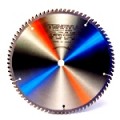How to Rip Aluminum Extrusions on a Table Saw
Note: You can cut aluminum on a table saw but you need to be very careful.
Question from a customer
I need your expertize. I do remodels and restorations in the LA area. One area of work is the installation of “insert” replacement windows- e.g. Marvin Replacement casements. The window is made to be inserted into the existing window opening, preserving all interior and exterior molding/trim. Gaps between the outside perimeter of the window and the existing opening are closed with aluminum frame extenders, that are cut to size and snap into the edge of the new window. My question-
Can I use a blade such as the PRA-255100DN on a table saw to rip the extrusion to the desired width? The material is supplied by Marvin in a fixed width (approx 2.5 in) and has to be ripped to 1.0 – 1.5 in, depending on the window. The material is thin, flat aluminum extrusion 1/16 x 2.5 in. I need to rip lenghts ranging from 18 in to 60 in. Of course, I will use a jig/sled to stabilize and clamp the material in place as it is cut? I would appreciate your advice.
Thanks,
Answer
Dear Sir:
Ripping aluminum extrusion on a table saw is not recommended for safety reasons. The problem is that the blade will grab the material and throw it at the operator.
Our recommendation for ripping aluminum on a table saw would be PR-25580D from Tenryu.
We recommend this because it has a 10 degree positive hook. Aluminum is usually cut with a negative hook but the positive hook will be much safer on a table saw. The positive hook will help hold the aluminum down.
It is very important that pressure be constantly applied to hold the material down. It is also very important that a riving knife be used.
You certainly can cut aluminum extrusion safely on a table saw with proper care. The concern is that aluminum can be grabby which can result in kickback.
Sincerely,
Tom Walz
We sell Tenryu Saw Blades
800 346-8274
Tags: About Carbide Processors, circular saws, Popular Tools, Tenryu
2 Responses to “How to Rip Aluminum Extrusions on a Table Saw”
Leave a Reply





I have been having an argument with several people regarding cutting aluminum on a table saw with the saw blade reversed so that the back of the teeth do the cutting. My argument was that it was possible, but not good practice. The others argued that it was a perfectly acceptable method. My argument was that the right saw blade should be used if it was done on a regular basis, but you could get away with the blade reversed, if done infrequently such as a DIY project where the cost of a different blade wasn’t warranted.
Dear Sir:
Executive Summary:
1. This is a case where the tool is being used in the direction it is weakest.
2. This practice may work with some saw blades but some saw blades are much weaker than others.
3. Saw blades, even from the same manufacturer, can vary greatly in quality.
4. Cutting situations that appear to be identical can vary greatly.
5. A circular saw is quite possibly the most dangerous tool the most people ever use. It is a very thin piece of somewhat brittle metal traveling at up to 200 mph.
6. Cutting accidents occur all the time and always by surprise. Anyone who has ever used a circular saw has had experiences with saw blades jamming or binding.
7. You never really know what you are cutting. The most obvious example is knots in wood or staples and nails in other materials. Metal is often regarded as an entirely homogenous material. If you have enough experience with metal than you realize how hard it is to get a sheet, bar, billet or similar to be 100% consistent.
You may not get hurt but you are greatly increasing the odds that you will.